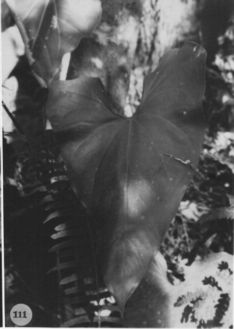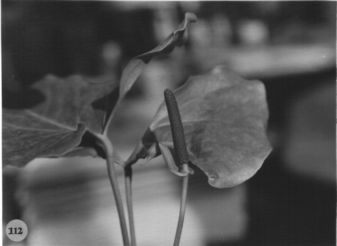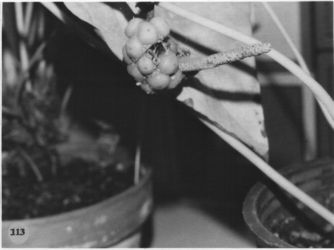





Anthurium montanum Hemsl.,
Diagn. PI. No Mexic. 36. 1878. TYPE: Guatemala, Volcán de Fuego, above Calderas al 2,700 m, Sa/i. (K).
Usually epiphytic, stems 5-15 cm long, 2.5 cm diam.; leaf scars 2.5 cm wide; roots numerous, thick, descending; cataphylls coriaceous. 12 cm long, rounded at apex with subapical apiculum, ca. 3 mm long, drying reddish-brown (B & K Yellow-red 5/7.5) usually persisting as fibers around stem.
LEAVES with petioles spreading to erect, (6.5)22-75(99) cm long, 5-15 mm diam., usually D-shaped, sometimes subterete, broadly sulcate, the margins acute; geniculum 1.5-3 cm long (sometimes tinged with red in larger plants); blades triangular to ovate, subcoriaceous, gradually to abruptly acuminate at apex, broadly to deeply lobed at base, 12-55 cm long, 7-30 cm wide, broadest at base; the anterior lobe 11-40 cm long; posterior lobes 5.5-18.5 cm long, usually directed upward; the sinus rarely arcuate, usually hippocrepiform or spathulate, rounded at apex; the upper surface semiglossy to glossy, the lower surface semiglossy; the midrib broadly raised at base above, acutely raised to middle, sunken at apex, convexly raised below; basal veins 3-7 pairs, the fourth to seventh coalesced 1-5.5 cm, raised above and below; the posterior ribs naked, the outer margin rolled up; primary lateral veins 6-11 per side, departing the midrib at 45°-60° angle; weakly sunken above, raised below, straight to the collective vein; lesser veins sunken above, raised below; collective vein arising from the first basal vein, sunken above, raised below, 5-14 mm from margin.
INFLORESCENCE spreading, shorter than or equalling leaves; peduncle 17-49(65) cm long, 3-8 mm diam., terete to weakly ribbed, shorter than petioles; spathe subcoriaceous, yellow-green to medium green, tinged with red-violet (B & K. Yellow-green 6/7.5 to 5/10), narrowly ovate to lanceolate, 6-8.5 cm long, 1.5-2.7 cm wide, broadest just above point of attachment, caudate-acuminate at apex, round to cordate at base, inserted at 90° angle on peduncle; stipe 2.5 cm long, 4 mm diam., yellow to medium green; spadix green tinged with purple, deep purple or brown, 4-20 cm long, 5-11 mm diam. at base, 4-8 mm diam. at apex; flowers rhombic to sub-4-lobed, 2.5-4.2 mm long, 2.6-4 mm wide, the sides straight to sigmoid; 5-9 flowers visible in the principal spiral, 5-6 flowers visible in the alternate spiral; tepals matte with pale puncta-tions, minutely and densely papillate, droplets sparse; lateral tepals 1.5-2.5 mm wide, the inner margins convex to straight and turned up against pistil; pistils weakly emergent, green; stigma linear, 0.5-0.7 mm long; stamens developing promptly from the base, the full complement developed promptly, the leading stamens preceding alternates only by 2 or 3 spirals; anthers cream to tan, 0.2 mm long, 0.5 mm wide, exserted on short, transparent filaments, quickly retracting; thecae oblong-ellipsoid, slightly divaricate; pollen yellow to cream, fading to white.
INFRUCTESCENCE pendent; spadix to 20 cm long, to 2 cm diam.; berries oblong to obtusely triangular, truncate and usually broadest at apex, medium orange (B & K Yellow-red 7/2.5), 10-13 mm in both directions; mesocarp firm, thick with few raphide cells; seeds 1-2, pale greenish-white, weakly flattened, ± reniform, 5-7.5 mm long, 4-6 mm wide, 3-4 mm thick, minutely appendaged at both ends. Figs. 111, 112, and 113.
Anthurium montanum is known only from southeast Chiapas and southwest Guatemala at elevations of 1,200 to 2,900 m in wet mountain forests and cloud forests (not designated as part of the Holdridge Life Zone system). In Chiapas the species is known principally from "bosque de oyamel" but probably also "bosque pino-cncino." The type locality of A. montanum, namely Volcán de Fuego, is located in southwest Guatemala along the frontiers of the departments of Escuinlla, Chimaltenengo, and Sacatepequez. According to annotations by N. E. Brown on the type collection, it consists of a mixed collection of two species, namely A. andicola and A. montanum. Despite my reluctance to question the generally excellent observations of Brown, I can see no differences in the two parts of the collection and certainly one part does not appear to be A. andicola.
The species is in section Belolonchium and is recognized by its narrowly ovate blades, its usually D-shaped, weakly glaucous petioles, long-pedunculate inflorescences with a matte, green to violet-purple spadix, and thin dilacerating cataphylls. Anthurium montanum is confused with A. huixtlense, a more wide ranging species usually occurring from about 300 to 1,500 m (to 1,800 m fide Flora of Guatemala). The latter species is distinguished from A. montanum by having coriaceous cataphylls that turn reddish-brown and persist intact, and by having a reddish-violet to lavender, rarely white spadix with glossy tepals. In A. montanum the cataphylls are thin and soon weather to slender fibers while the tepals are matte and either green or violet-purple.
Anthurium montanum is also similar to A. umbrosum, a species from northern Oaxaca with similar narrowly ovate leaf blades and dilacerating cataphylls, but that species differs in having a terete petiole and a leaf blade that is relatively straight along the margin. Anthurium montanum is perhaps most closely related to A. titanium, a species from southeast Chiapas and adjacent parts of Guatemala and sympatric with A. montanum in the lower pans of its elevational range (i.e., below 1,800 m). The two species share a D-shaped, weakly glaucous petiole and leaf blades of similar color and texture, but those of A. titanium attain generally much larger size and are almost round to broadly ovate in outline, while those of A. montanum are generally narrowly ovate. Another species with which A. montanum can be confused is A. chamulense, with which it is sympatric in eastern Chiapas. They share a similar blade shape but the latter species is distinguished by having blades more coriaceous. Anthurium montanum is apparently closely related to A. cordatotriangulum, which differs in having a more deltoid leaf blade with conspicuously elevated veins, a generally longer and broader spathe, and a longer, more tapered spadix. Both species have been collected near Rosario south of Motozintia, but the only species apparently now occurring in the area is A. montanum.
 |
 |
 |
Map of Mesoamerican specimens with coordinates
Guatemala Guatemala: Volcáno Pacaya, 2200 m.,, 23 Aug. 1970, Harmon
4176 (UMO 92835).
Mexico Chiapas: Mt. Ovando, 1800 m,, 1 July 1940, Matuda 4212 (LL,
UCLA).
Mexico Chiapas: 2016 m,, 19 May 1945, Matuda 5604 (LL).
Mexico Chiapas: Mun. La Trinitaria, 1230 m,, 15 May 1988, Breedlove
& Bourell 67929 (CAS).
Mexico Chiapas: 2100 m, 15.20N 92.15W, 5 May, 1987, James S. Miller,
John K. Myers & Estaban Martínez 2678 (MO).
Mexico Chiapas: 2100 m, 15.20N 92.15W, 5 May, 1987, James S. Miller,
John K. Myers & Estaban Martínez 2679 (MO).
Mexico Chiapas: 1900-2010 m, 15.06N 92.05W, 5 May, 1987, James S. Miller,
John K. Myers & Estaban Martínez 2700 (MO).
Mexico Chiapas: 1800 m,, 10 July 1977, Thomas B. Croat 40751 (MEXU,
MO).